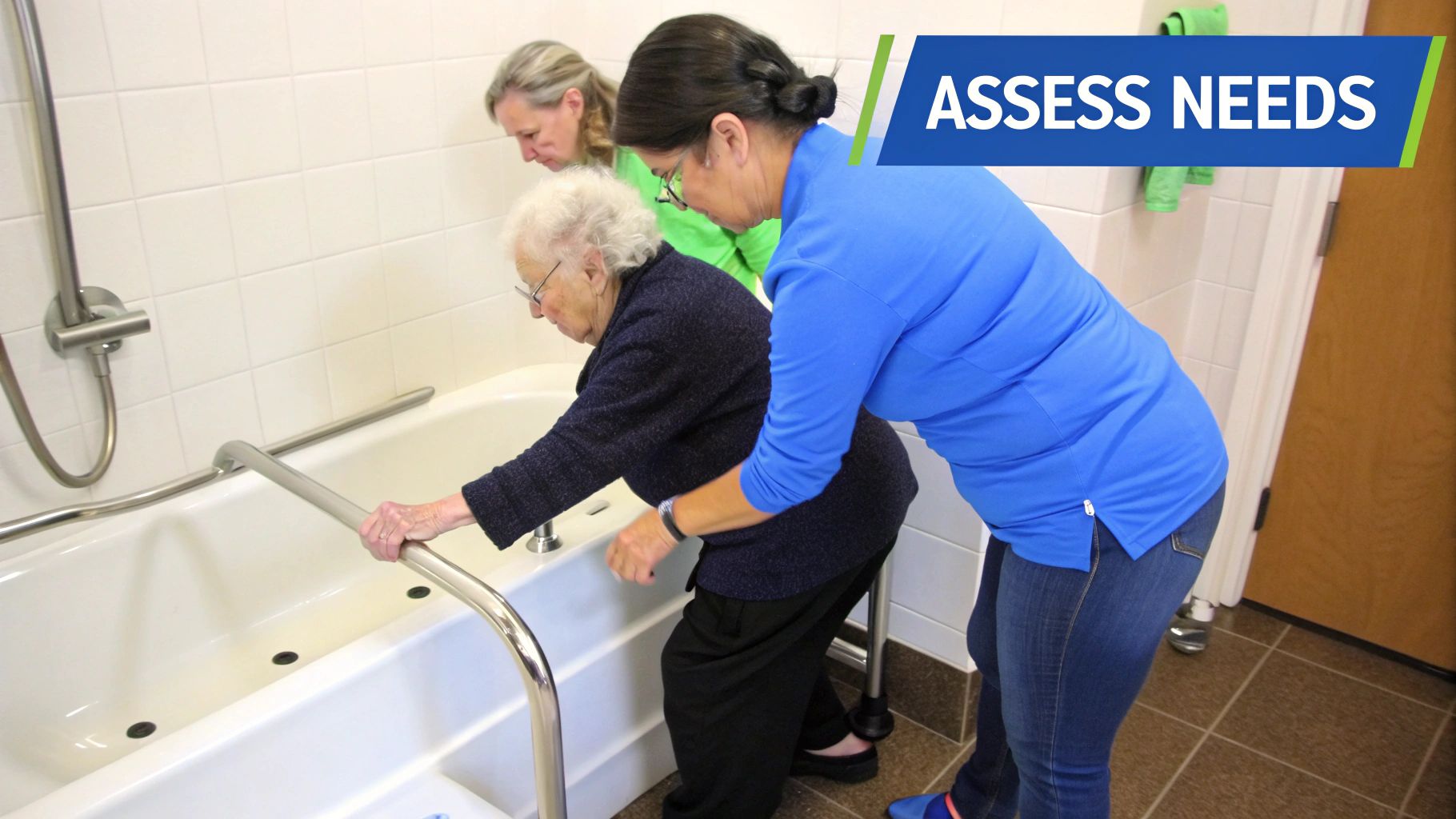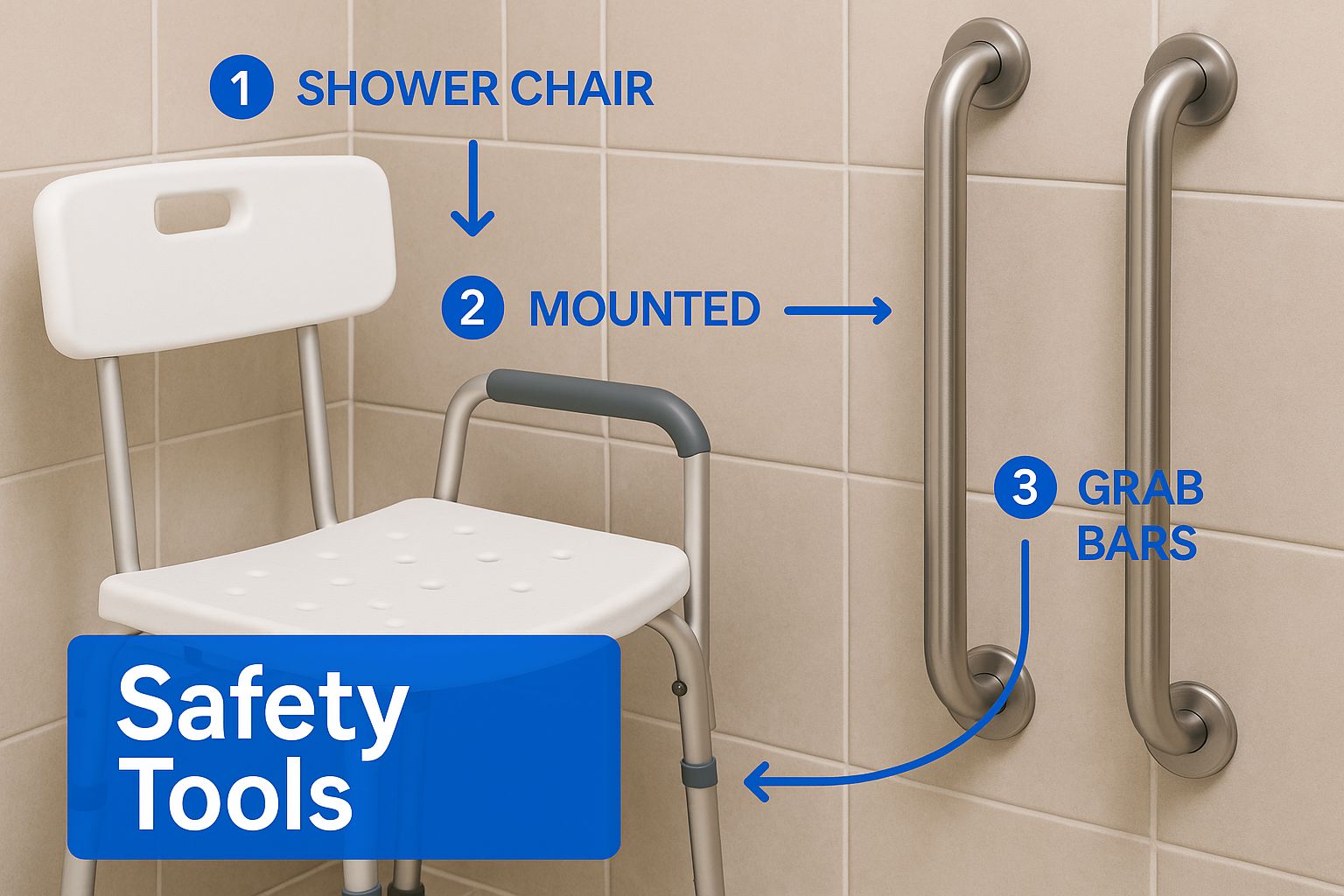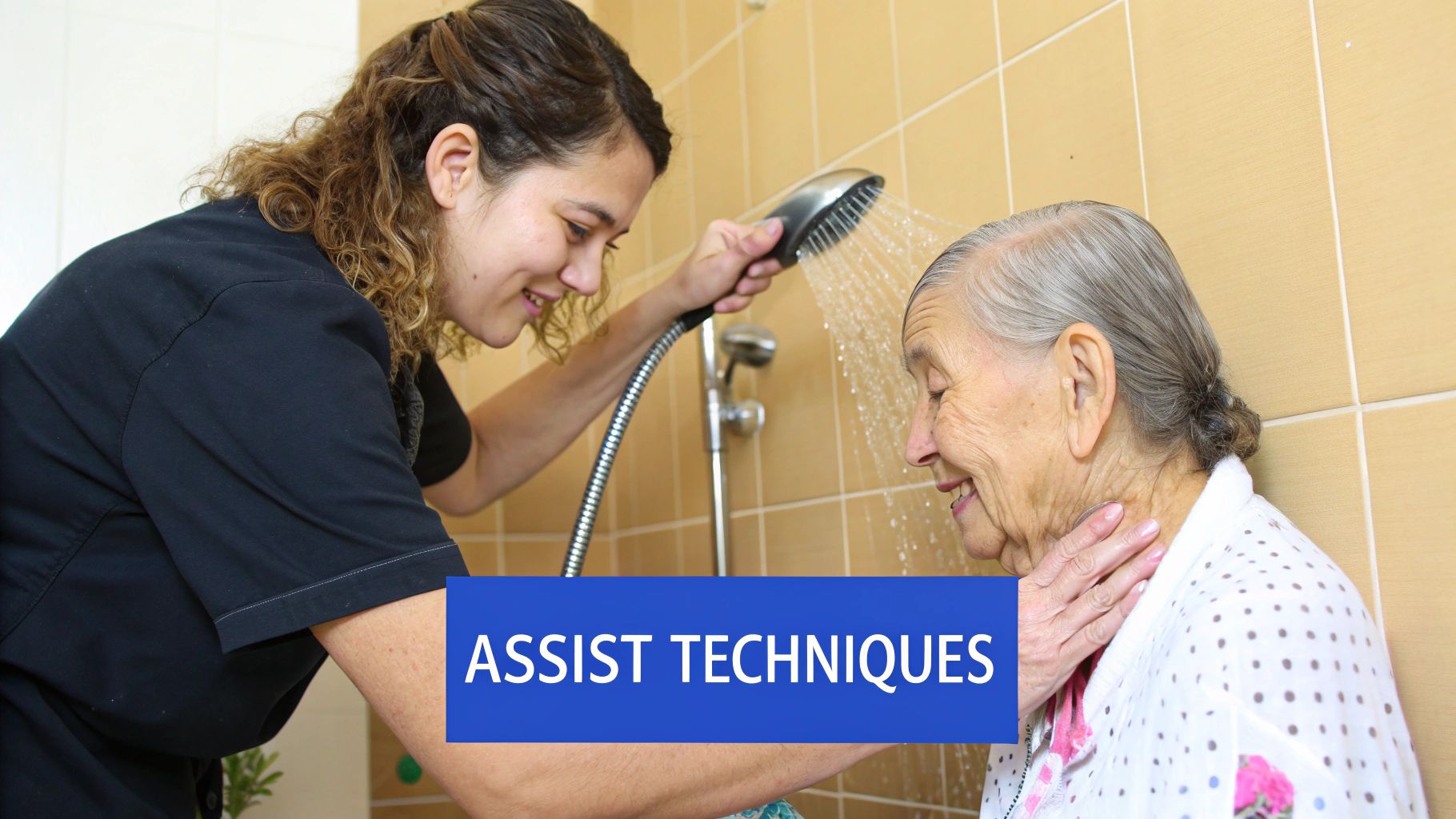Why Bathing Assistance Matters: Beyond Basic Hygiene
Bathing is about more than just staying clean; it's a crucial part of overall well-being, especially for seniors. As we age, everyday tasks like bathing can become difficult due to changes in mobility, balance, and cognitive abilities. This can turn a once-private act into a potential safety risk, affecting both physical and emotional well-being. The challenge lies in finding a balance between providing necessary support while preserving a senior's independence and dignity.
The Significance of Safe and Comfortable Bathing
Bathing assistance is essential for maintaining hygiene, preventing skin infections, and promoting overall comfort. Regular bathing helps remove dirt, sweat, and bacteria that can lead to skin irritation and infections. It also provides a chance to check for skin changes, like pressure sores or rashes, allowing for early treatment. Beyond hygiene, the warm water and gentle touch of bathing can be soothing and therapeutic, encouraging relaxation and reducing stress.
The Emotional Impact of Bathing Assistance
The emotional aspects of bathing assistance are just as important as the physical ones. Many seniors feel vulnerable and experience a loss of independence when they need help bathing. This is completely understandable, given the personal nature of this activity. Sensitive and respectful assistance can help preserve a senior's dignity and self-esteem.
Caregivers should focus on open communication, offering choices whenever possible, and respecting privacy. Even something as simple as letting a senior choose their soap or the water temperature can make a big difference.
The increasing need for bathing assistance is evident in the growing market for assistive devices. The global market for bathroom and toilet assist devices was valued at about $4.63 billion in 2024 and is projected to reach $4.92 billion in 2025. Find more detailed statistics here This growth is largely due to the rising aging population, with the number of people aged 80 or older expected to triple between 2020 and 2050. This highlights the increasing recognition of bathing assistance as not just a convenience but a vital part of senior care. Providing effective and compassionate bathing assistance is key to supporting seniors as they navigate the challenges of aging.
Transforming Bathrooms: Essential Safety Equipment That Works
The right equipment can truly make a difference, turning a potentially stressful bathing experience into a comfortable and safe part of the daily routine. Instead of just listing various products, let's delve into what genuinely works, drawing from the experiences of caregivers. This involves understanding how to choose and install equipment that provides effective support and promotes independence.
Choosing the Right Support: Grab Bars, Shower Chairs, and Transfer Benches
Grab bars are crucial for maintaining stability, but it's important to remember that not all grab bars are equal. Look for bars that can support a significant amount of weight and ensure they are securely mounted to wall studs. Avoid grab bars that attach with suction cups, as these are not reliable for supporting weight. Shower chairs offer a safe and stable place to sit while showering, minimizing the risk of falls. When choosing a shower chair, consider the individual's height and weight to ensure adequate support and comfort. Transfer benches greatly simplify the process of getting in and out of the tub or shower. These benches extend over the edge of the tub, allowing the person to slide across rather than stepping over the high side. For further information on home modifications, you can explore this resource: How to master home modifications.
Quality Matters: Consumer vs. Professional Grade
A key distinction exists between consumer-grade and professional-grade bathing equipment. Professional-grade equipment is designed for more frequent and demanding use, often featuring higher weight capacities and increased durability. While the initial cost may be higher, the long-term advantages, including enhanced safety and reduced maintenance, make it a worthwhile investment.
This distinction becomes even more critical as the need for specialized bathing assistance increases. Projections indicate that the global market for elderly bathroom solutions is expected to hit $15 billion by 2025, highlighting the growing demand for safe and accessible bathing options. Explore this topic further

Fostering Independence: Introducing Equipment Effectively
Introducing new bathroom safety equipment can sometimes be met with resistance. It's helpful to frame these aids as tools that enhance independence, rather than as signs of declining abilities. Explain how the equipment will improve safety and comfort during bathing, emphasizing the individual's continued control over their personal hygiene routine.
The following table provides a comparison of essential bathroom safety equipment, outlining key benefits, installation needs, and cost considerations.
Essential Bathroom Safety Equipment Comparison: This table compares different types of bathroom safety equipment for elderly bathing assistance, including their features, benefits, installation requirements, and price ranges.
| Equipment Type | Key Benefits | Installation Complexity | Approximate Price Range | Maintenance Requirements |
|---|---|---|---|---|
| Grab Bars | Increased stability and support while standing, transferring, or using the toilet | Simple to complex, depending on wall type and mounting method; professional installation recommended for secure weight-bearing capacity | $20 – $100+ | Periodic inspection of mounting hardware; cleaning |
| Shower Chairs | Provides a secure and comfortable place to sit while showering, reducing fall risk | Minimal; some assembly may be required | $30 – $200+ | Regular cleaning; checking for wear and tear |
| Transfer Benches | Facilitates safe entry and exit of the tub or shower by allowing sliding transfer | Minimal; no permanent installation required | $50 – $300+ | Regular cleaning; checking for stability and wear |
This comparison highlights the variety of equipment available to enhance bathroom safety and independence. Choosing the appropriate equipment depends on individual needs and preferences. Consult with an occupational therapist or healthcare professional for personalized recommendations.
The Bathing Process Mastered: A Step-by-Step Approach
Selecting the right equipment involves careful consideration of available space. For instance, understanding standard bathroom vanity cabinet dimensions can be incredibly helpful. But beyond the physical setup, the actual process of assisting with bathing is crucial. Let's explore how to create a comfortable and safe bathing experience for elderly loved ones.
Preparation is Key: Setting the Stage for a Positive Experience
Before even beginning, gather all the necessary supplies. This includes towels, soap, shampoo, lotion, and any assistive devices like a shower chair or grab bars. A warm bathroom, free of drafts, is essential to prevent chilling. Then, check the water temperature. Older adults are often more sensitive to temperature changes, so test the water yourself beforehand. A calm and reassuring atmosphere makes all the difference.
The Bathing Process: Step-by-Step Guidance
With everything ready, the bathing process can begin. Gently assist the senior into the shower or bath, using a transfer bench if necessary. If a shower chair is used, ensure it's stable and the individual is comfortably seated. Communication is vital throughout the process. Explain each step before performing it, offering choices whenever possible, such as asking if they prefer to wash their hair first or last. This empowers the individual and preserves their dignity.

This infographic highlights important safety tools. The grab bars and shower chair demonstrate how a secure bathing environment can be created.
Adapting the Process: Addressing Individual Needs
Different mobility levels require different approaches. The following table provides an overview of various bathing methods and considerations.
To help understand the best approach for various levels of mobility, the following table summarizes key aspects of bathing assistance.
Bathing Methods for Different Mobility Levels
| Mobility Level | Recommended Bathing Method | Required Equipment | Assistance Level | Safety Considerations |
|---|---|---|---|---|
| Limited | Bed Bath | Basin, washcloths, towels, no-rinse cleanser | High | Skin integrity, maintaining warmth, careful positioning |
| Some Mobility | Shower with Chair | Shower chair, hand-held shower head, grab bars | Moderate | Secure transfer to and from chair, preventing slips |
| Can Stand with Assistance | Shower with Grab Bars | Grab bars, non-slip mat | Minimal | Monitoring balance, ensuring secure footing |
This table provides a quick guide for selecting the right bathing approach based on individual needs. Remember, safety and comfort are paramount.
Post-Bath Care: Ensuring Comfort and Safety
After bathing, gently dry the senior, paying particular attention to skin folds to prevent irritation. Applying lotion helps moisturize and protect the skin. Finally, assist with dressing as needed, ensuring the senior is warm and comfortable. This concludes the bathing process, hopefully a positive and respectful experience.
When to Call in the Professionals: Navigating Care Options
Family caregivers provide invaluable support to their aging loved ones. However, there are times when professional bathing assistance becomes essential. Knowing when and how to incorporate this support can significantly improve the quality of life for both the senior and the caregiver. This involves understanding the different care options and choosing the best fit for individual needs and circumstances.
Evaluating In-Home Services, Day Programs, and Residential Care
Several options exist to provide professional bathing assistance for elderly individuals. In-home care allows seniors to remain in the comfort of their own homes while receiving personalized support. Adult day programs provide structured activities and care during the day, offering respite for family caregivers. For seniors requiring more comprehensive care, residential options such as assisted living facilities offer 24/7 support, including bathing assistance. You might be interested in: How to master home care for the elderly. Each option presents unique benefits and considerations, making careful evaluation a crucial step.
Understanding the Costs and Payment Options
The cost of professional bathing assistance varies depending on several factors. These include the type of service, geographic location, and frequency of care. In-home care costs can range from hourly rates to weekly or monthly packages. Adult day programs typically charge a daily or weekly fee. Residential care often involves significant monthly costs. Understanding payment options, including insurance coverage, Medicaid, and private pay, is essential for effective budgeting and financial planning.

Assisted living and institutional care are seeing increased demand. According to reports, nearly one million Americans currently reside in assisted living communities, with the majority being women aged 85 and older. This demographic is projected to grow by 240% globally by 2040. This highlights the growing need for services like bathing assistance. Discover more insights about elderly care services This rising demand reinforces the importance of planning ahead and researching the available resources.
Identifying Quality Care: Key Questions to Ask Providers
When considering professional bathing assistance, identifying quality care is paramount. Ask potential providers about their staff's training and experience, particularly in working with seniors. Inquire about their approach to preserving dignity and respecting individual preferences during bathing. Clear communication and individualized care plans tailored to each senior’s unique needs are crucial aspects of quality care. Understanding the provider’s policies regarding scheduling, cancellations, and emergencies is also vital.
Transitioning to Professional Care: Ensuring a Smooth Process
Transitioning from family caregiving to professional assistance can be a sensitive process. Open communication with your loved one is key to a smooth transition. Explain the reasons for the change, emphasizing the benefits of professional care. Sharing information about the caregiver’s qualifications and experience can help alleviate any anxieties. Consistent communication between the family, the senior, and the professional caregiver ensures everyone is informed and working together. Sharing established bathing preferences and routines also helps maintain consistency and comfort for the senior.
Beyond Basics: Bathing Assistance for Complex Conditions
Standard bathing assistance doesn't always meet the unique needs of seniors with specific health conditions. Adapting your approach is crucial for comfortable and safe bathing experiences. Let's explore tailoring assistance for conditions like dementia, Parkinson's disease, arthritis, and stroke recovery.
Dementia and Bathing Anxiety: Creating a Calm and Predictable Experience
Individuals with dementia can experience increased anxiety around bathing. A calm, predictable environment can significantly reduce this. Use clear, simple language to explain each step. A consistent routine, bathing at the same time each day in the same location, also helps. Soft lighting, calming music, and a warm room temperature can further enhance relaxation.
Parkinson's Disease and Freezing Episodes: Ensuring Safety and Support
Freezing episodes, common in Parkinson's disease, can make bathing challenging. Ensure adequate support during transfers and while standing or sitting. Grab bars provide crucial stability. Non-slip mats inside and outside the tub or shower minimize fall risks. If freezing occurs, encourage deep breaths and weight shifting or rocking to initiate movement.
Arthritis and Pain Management: Minimizing Discomfort During Bathing
Arthritis can make movement painful, making bathing difficult. Warm water soothes stiff joints, but avoid extreme temperatures. Gentle, supportive movements are essential when assisting with transfers and washing. Assistive devices like shower chairs and long-handled sponges can reduce reaching and bending, minimizing discomfort.
Stroke Recovery and Adaptive Bathing Techniques: Promoting Independence and Rehabilitation
Adapting bathing techniques after a stroke is vital for physical and emotional well-being. Depending on the stroke's impact, equipment like bath lifts or transfer benches may be necessary. Focus on encouraging independence with appropriate support. Occupational therapy can provide guidance on adaptive techniques and exercises to improve mobility during bathing. Learn more in our article about Home health care for seniors.
Skin Condition Management: Addressing Dryness and Pressure Areas
Healthy skin is a critical part of bathing assistance, especially for seniors. Dry skin is common and can be addressed with moisturizing lotions or creams after bathing. Be watchful for pressure areas, especially over bony prominences, which can become pressure sores. Regularly inspect the skin for redness, irritation, or breakdown. When planning care, consider the financial aspects, including long term care insurance cost. These adaptations can make bathing more comfortable and less daunting for seniors with specific health conditions.
The Human Element: Preserving Dignity in Every Interaction
Providing bathing assistance to elderly loved ones requires more than just technical skills. It's about fostering a connection and preserving their dignity during a vulnerable moment. How we interact during this personal care activity significantly impacts their emotional well-being. It’s about understanding their feelings and approaching the task with empathy and respect.
Communication is Key: Transforming Awkwardness into Comfort
Many seniors feel vulnerable and may experience a sense of lost independence when requiring bathing assistance. This is a natural response given the intimate nature of the task. Open communication can transform potentially awkward situations into comfortable, matter-of-fact care.
Instead of abruptly starting the process, try offering a choice: "The water is warm now. Would you like to step in when you’re ready?" This simple gesture of giving them control, even over a small decision, can significantly impact how they feel.
Gradual Introductions and Respectful Adaptations
Introducing assistance gradually can help seniors adjust to needing help. Begin by offering support with specific tasks, such as washing their back or hair. Gradually increase assistance as needed, allowing them time to adapt.
Respecting cultural bathing traditions is also essential. Some cultures have specific rituals or preferences. Incorporating these into the routine can create a more comfortable and familiar experience.
Gender Preferences and Sensitive Handling
Be mindful of gender preferences whenever possible. If a senior prefers a caregiver of the same gender, make every effort to accommodate their request. Open communication can help build trust and alleviate any potential discomfort if this isn't feasible. Offering options for covering up during the bathing process can also help preserve modesty and dignity.
Addressing Resistance with Compassion
Resistance to bathing is common and often rooted in underlying fears or concerns. Acknowledge these feelings with compassion. Instead of dismissing their worries, try to understand the reason behind their resistance.
If they fear falling, reassure them about the safety measures in place, such as grab bars and non-slip mats. If they're experiencing pain, explore ways to minimize discomfort, such as using warm water and gentle movements. How you provide assistance, including your tone of voice, pace, and overall attitude, makes a difference. A gentle touch, a reassuring voice, and a patient demeanor can significantly improve the experience.
By prioritizing the human element in bathing assistance, we can ensure this essential care activity becomes a positive and respectful experience for both the senior and the caregiver.
Contact Caring Hands Senior Services today at https://caringhandsseniorservices.org for compassionate and personalized in-home care that prioritizes the dignity and well-being of your loved ones. We serve Mercer County, including Hamilton, Princeton, and surrounding areas.


